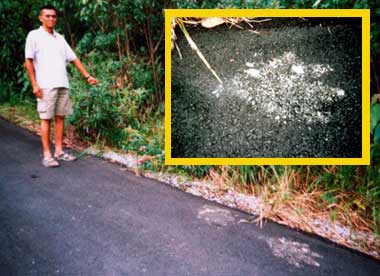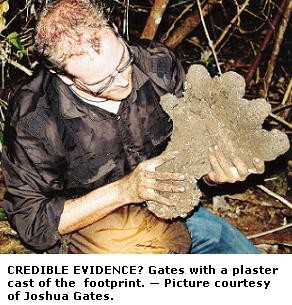Who Was On That Malaysian Expedition?
Posted by: Loren Coleman on February 22nd, 2006
An explosion of media attention today…at least three articles hitting the internet…news of an expedition…backing by a television show…a photograph of a footprint…and more. Fasten your seat belts.
Sometimes it is only location and funding that separate cryptozoologists from the action. As I’ve been suggesting for weeks, Malaysian scientists are the obvious choices for going into the rainforest to look for their own "Bigfoot" first.
Reports now from a London paper indicate that a team of "paranormal investigators," including an Australian tracker, a filmmaker from Los Angeles, a reality film crew, and apparently a British reporter are in hot pursuit too. Cryptomundo takes a closer look at who was on the expedition and learns a little more about how scientific their adventure was.
The expedition account is being published on the same day when Malaysian Bigfoot claims are getting wilder and wilder, as per this Bermana report: A colony of "Bigfoot" believed to be roaming the jungles of Johor is said to have moved there from the jungles around Gerik in Perak…The colony, now numbering about 40, had originated as a group of 17 and had moved away due to three main reasons — the skirmishes between soldiers and communist guerrillas in the early 70s, construction of the East-West Highway and the building of a dam….the Bigfoot seemed to be a mix of man and ape, with a ratio of 70 per cent and 30 per cent respectively, and easily reached a height of 10 to 12 feet for an adult and six to seven feet for a young one.
Nevertheless, some intriguing new findings are afoot.
The down-to-earth London-based Independent on January 22, 2006, is carrying a lengthy and well-written overview of the expedition by Jan McGirk.
How are some of their findings described?
"A four-inch impression in the mud of the Malaysian rainforest."
But was it four-inches long? Wide? Deep?
They saw "tree branches 11 feet overhead had been damaged, directly above the spot where the animal’s left heel had sunk four inches into a muddy puddle. A stick had snapped beneath one of its toe depressions."
Is there any relationship between the footprint and the tree damage, other than location?
"A second fresh footprint proved impossible to find but recent damage to a rotting log, located a couple of strides away, suggested it had might have borne a prodigious weight."
As McGirk writes:
For the excitable team of Yeti hunters, mainly a mix of Singapore enthusiasts and volunteers from the capital Kuala Lumpur it was vindication. Even the sceptics, including this reporter, were secretly impressed.

As with the two extremely faded footprints that had been found preserved in fresh tar on a nearby road, this print measured nearly a triple handspan across, roughly 11 by 19 inches. The Australian tracker Tony Burke, part of the Singapore team, estimated that to make such a print, an animal would have to weigh at least 240kg.
"I’m a cynic, but if we could see a right footprint as well, we could at least measure its gait. Maybe if we had some scat, I could be totally convinced," he said. "I am about 50 per cent there. Let’s see what the lab results are."
Did this reporter say "Tony Burke" from Australia? The best known Tony Burke from Australia is Anthony Stephen "Tony" Burke (born November 4, 1969), a Australian politician who was elected to the House of Representatives as member for the seat of Watson, New South Wales for the Australian Labor Party during the 2004 federal election. Tony Burke is known for his interest in animals and immigration policies. Intriguingly, this Australian Labor Party Tony Burke grew up in Beverly Hills in a small business family, so maybe he knows Josh Gates (see below). Of course, I wait to learn more from my cryptozoologist associates in Australia to tell me if they know who Tony Burke is.
Continuing reading..
An official government committee of research scientists, appointed by Abdul Ghani Othman, chief minister of Johor state, has been trying to verify Bigfoot’s existence since late January, by interviewing witnesses, setting upcamera traps in its likely haunts, and collecting evidence from tribal informants in the national parks.
But our paranormal investigators’ search party, tailed by an excitable science-fiction film crew from Los Angeles, was anything but stealthy. Kong Kam Choy, a 40-year-old construction worker who likes to trek through the jungle in his free time, convinced the gaggle of researchers to tramp through a leech-infested grove near a palm plantation where he had come across unusually big tracks that he could not readily identify.
It was just two hours before dusk, thunder was rumbling and the group was disappointed, having made a futile afternoon voyage upriver to examine a set of tracks discovered on 10 January near the Tanjung Sedili creek. These had since been washed away by tropical downpours and overrun by wild boar.
Then we struck gold. Kenny Fong, an e-commerce professor who founded Singapore Paranormal Investigators five years ago, came running when Josh Gates, a sci-fi documentary maker, summoned him to check out the peculiarly large footprint.

Okay, stop everything there. Is this Josh Gates, the actor and reality show contestant, born August 10, 1977, according to his Internet Movie Database profile, that was in "Beg, Borrow & Deal" (2002), the reality TV series? The guy that was the "Butler" in the movie "Party Foul" (2003) and the still photographer for the film "The Vest" (2003)? The Josh Gates in Malaysia, who is being shown in the New Strait Times with the footcast he found, is the host of Destination Truth, a new television program to be shown over the Sci-Fi Network in the United States.

What seems clear so far is that media funding – from reality programming in Malaysia and California – is supporting new "discoveries," but the question remains, will the evidence be destroyed in the collecting or only shown on television?
Back to the paper..
Professor Fong considers himself a debunker who is keen to spot a hoax. Using a police crime scene kit designed to preserve footprints for court evidence, he set about the job. A technician required three full bags of plaster (at about 1lb a bag) to fill the huge depression made by the single footprint. The muddy size 20 footprint was doused with hairspray before quick-setting plaster was poured into each crevice.
As the group gawked and cameras whirred, the print took on that unmistakable and almost comically ominous Bigfoot shape – the flat foot with four rounded digits, plus a gorilla-like big toe jutting out from the side. "People say Bigfoot doesn’t exist, and I have had my doubts. But what else could it be?" asked Professor Fong, who promptly toppled off a hillock in his excitement to photograph the group in front of the fresh paw p
rint.
According to Vincent Chow, a Malaysian bio-diversity expert, this area of diverse rainforest has been rife with Bigfoot sightings all month. "An elephant has been foraging in those woods for food, so farmers set off explosives to frighten it away from their fields," he said. "But animals get accustomed to these blasts and ignore them. Now we think a Bigfoot family of three may be shadowing the elephant, who clears the way.
"Fourteen large footprints were found nearby on Saturday. Then at 4am, workers were awakened by 10 minutes of weird hooting, a kind of call and response session, while they were asleep at a palm oil plantation." The planter, Abdul Rahman Ahmad, said his terrified workers at Komping Lukut described the eerie night cries as long drawls in three distinct pitches. "They said it sounded like squeals of wild pigs mixed up with the deep barks of gibbons – but not like owls," he recounted. They also heard heavy crashing through the underbrush. Mr Chow speculated that at least three different animals, which the local tribes call Hantu Jarang Gigi, or "snaggle-toothed ghosts", must have been involved in this curious chorus.
The article’s midsection has the usual summary of historical information, a quick review of some of the Malaysian reports, the standard supportive quote from Jane Goodall, and comparasions with Bigfoot reports worldwide. Then back to some further new details:
In Malaysia, Mawas-mania is building, fuelled partly by television. The plaster cast from Bukit Lantang woods will be presented to government scientists by Syed Abdullah Alattas, a Malaysian celebrity better known as "Uncle", who stars in a popular reality show called Seekers. Every week he tracks down the paranormal on camera, invariably surrounded by a group of female acolytes armed with daggers, who squeal fetchingly whenever they encounter the unknown.
For our trip, the Seekers crew had brought in an array of arcane equipment, including remote control robot cameras, infrared goggles and sound-enhancers, but the fresh footprint was found by chance. During a demonstration of the sound-boosting sensors before we left for the jungle, it was easy to distinguish whether restaurant diners were chewing on breakfast croissants or toast. But, during a 12-hour monitoring period in the forest, no aural trace of the bigfoot was detected.
Lack of evidence is not likely to slow the bandwagon building momentum in Kuala Lumpur though. Cartoons show a giant ape straddling the landmark Petronas Towers and grinning rubber-ape masks are being hawked at traffic lights in the city centre. Despite the growing excitement, there have been no urban sightings of Bigfoot. So far, the only sign of the primates has been found in the southern wilds, usually close to the water.
Meanwhile, back in the jungle, the encounters were real:
Hamid Mohd Ali, a frog-catcher from the Orang Asli tribe, claims he came eye to eye with a giant ape, which his people call the "Siamang", late last year. Other locals allege that they saw the giant creature cross the road at twilight or leap down from a river bank.
"We believe that people can only see it once in a lifetime," Hamid told reporters. "But in this year alone, four villagers have seen it [the Bigfoot] and we think this is because of the shrinking jungle."
Well, stay tuned.
About Loren Coleman
Loren Coleman is one of the world’s leading cryptozoologists, some say “the” leading living cryptozoologist. Certainly, he is acknowledged as the current living American researcher and writer who has most popularized cryptozoology in the late 20th and early 21st centuries.
Starting his fieldwork and investigations in 1960, after traveling and trekking extensively in pursuit of cryptozoological mysteries, Coleman began writing to share his experiences in 1969. An honorary member of Ivan T. Sanderson’s Society for the Investigation of the Unexplained in the 1970s, Coleman has been bestowed with similar honorary memberships of the North Idaho College Cryptozoology Club in 1983, and in subsequent years, that of the British Columbia Scientific Cryptozoology Club, CryptoSafari International, and other international organizations. He was also a Life Member and Benefactor of the International Society of Cryptozoology (now-defunct).
Loren Coleman’s daily blog, as a member of the Cryptomundo Team, served as an ongoing avenue of communication for the ever-growing body of cryptozoo news from 2005 through 2013. He returned as an infrequent contributor beginning Halloween week of 2015.
Coleman is the founder in 2003, and current director of the International Cryptozoology Museum in Portland, Maine.









